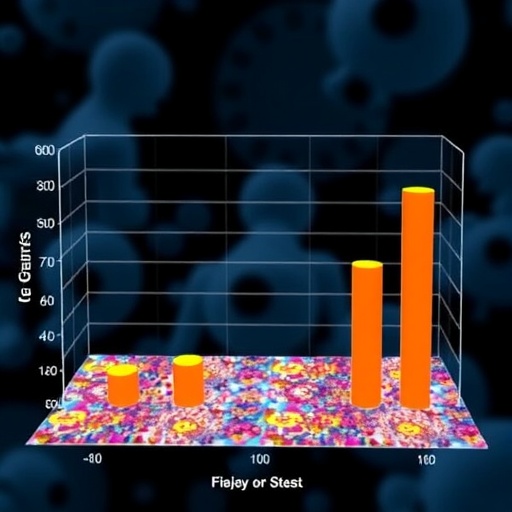
In an era dominated by wireless connectivity and digital interactions, smartphones have transcended their utilitarian origins to become near-omnipresent extensions of the self, especially among adolescents. Yet this pervasive presence has not come without cost. Recent groundbreaking research conducted by Liang, Wei, Jiang, and colleagues delves deep into the nuanced interrelationship between problematic smartphone use and cognitive failures among junior and senior high school students. This study, published in the International Journal of Mental Health and Addiction in 2025, intricately compares the underlying network structures of these two phenomena, offering new insights that may redefine our understanding of adolescent mental health in the digital age.
Smartphones are no longer simple communication devices; they embody complex ecosystems of social media, gaming, streaming, and constant notifications—all designed to capture and hold users’ attention. While these functions offer considerable benefits, they also present fertile ground for problematic usage patterns. Such usage is characterized by excessive, compulsive habits that interfere with daily functioning, including academic performance and social relationships. Liang and colleagues’ work unpacks this complexity by examining how problematic smartphone use correlates with cognitive breakdowns that manifest as lapses in memory, attention, and executive functioning among teenagers.
What sets this study apart is its application of network analysis—a sophisticated mathematical technique that maps and analyzes interconnections within complex systems. Instead of viewing problematic smartphone use and cognitive failures as isolated symptoms, this approach conceptualizes them as interconnected nodes within broader behavioral and cognitive networks. By comparing these networks between junior and senior high school populations, the researchers illuminate how developmental stages influence the structure and interplay of these mental health challenges.
.adsslot_WGnFKUl8Er{width:728px !important;height:90px !important;}
@media(max-width:1199px){ .adsslot_WGnFKUl8Er{width:468px !important;height:60px !important;}
}
@media(max-width:767px){ .adsslot_WGnFKUl8Er{width:320px !important;height:50px !important;}
}
ADVERTISEMENT
Their results reveal striking differences in the network topologies between the two age groups. Among junior high students, problematic smartphone use tends to cluster closely with symptoms related to attention deficits and forgetfulness. This could suggest that early adolescents’ brains, still in critical phases of development, are particularly vulnerable to the attentional fragmentation fostered by smartphone distractions. Conversely, for senior high students, the network connections are more diffuse, with problematic smartphone use linking more strongly to emotional regulation and decision-making failures. This shift may reflect the increasing complexity of cognitive demands faced during late adolescence and greater emotional volatility.
One of the pivotal revelations of this research is the identification of “bridge symptoms” within these networks—key behaviors or experiences that connect problematic smartphone use to cognitive failures. For example, among younger teens, difficulty concentrating emerged as a principal bridge, suggesting that interventions targeting attention enhancement might mitigate both smartphone overuse and cognitive lapses. In older adolescents, susceptibility to stress and impulsivity played similar intermediary roles. These findings offer crucial leverage points for developing age-specific prevention and treatment programs tailored to distinct developmental needs.
Cognitive failures—a term encompassing everyday mental slips, from forgetting appointments to misplacing items—are often overlooked but serve as important indicators of underlying cognitive strain and dysfunction. By systematically mapping their association with problematic smartphone use, Liang and colleagues underscore the real, measurable consequences of digital behavior patterns on brain function. The study therefore challenges a popular misconception that smartphone overuse is merely a social or behavioral issue and suggests it has deeper neuropsychological ramifications.
The methodology of the study deserves particular praise. Utilizing self-reported questionnaires from a large cohort of junior and senior high students, paired with advanced network modeling algorithms, the researchers were able to capture intricate dynamic relationships that traditional correlational studies often miss. This methodological innovation highlights the growing role of computational psychiatry in mental health research—a field that merges clinical insight with data science to unravel complexities of the human mind.
Of course, this research is not without limitations. Self-report instruments can introduce biases related to participants’ self-awareness and honesty. Moreover, the cross-sectional nature of the study precludes definitive causal conclusions; it is unclear whether smartphone overuse leads to cognitive failures, or vice versa, or if both emerge from a common underlying vulnerability. Longitudinal studies and experimental designs will be critical next steps in further illuminating these pathways.
Despite these constraints, the implications of Liang and colleagues’ findings are profound. They suggest that mental health professionals, educators, and policymakers should view problematic smartphone use through a neurocognitive lens rather than a purely behavioral one. Interventions might combine traditional behavioral therapies with cognitive training and stress management to holistically address the interconnected web of symptoms.
Furthermore, the differentiation between junior and senior high school students advocates for developmentally sensitive programming. Early adolescence appears to be a critical window for attention-related interventions to curb emerging problematic smartphone patterns. As youths transition into older adolescence, emotional regulation and impulsivity become more central, requiring tailored support that addresses these evolving cognitive dimensions.
From a public health perspective, the study punctuates the urgency of addressing the digital environment in which today’s youth are enmeshed. Schools might incorporate digital literacy curricula that emphasize mindful and intentional smartphone use, while parents and guardians could foster environments that balance digital engagement with offline activities to promote cognitive resilience.
This research also hints at the emerging frontier of personalized mental health. Network analysis could one day be applied on an individual level to map personal symptom structures, optimizing intervention plans for each adolescent. By pinpointing which cognitive failures most strongly interlink with problematic behaviors, therapeutic efforts can become more precise and effective.
In the global context, problematic smartphone use is not confined to any single culture or socioeconomic strata, though patterns may vary widely. Liang and colleagues’ study, conducted in China, adds valuable geographic diversity to the literature, highlighting universal anxieties surrounding adolescent digital use while also flagging culturally specific dynamics. Cross-cultural comparative studies could further enrich this understanding.
Finally, as smartphone technology continues to evolve rapidly—with virtual reality, augmented reality, and AI-driven applications expanding—the landscape of adolescent smartphone interaction will become ever more complex. The cognitive challenges identified by this study may deepen or morph in unforeseen ways, underscoring the need for ongoing research and adaptive mental health strategies informed by robust, cutting-edge analytic techniques.
In conclusion, Liang, Wei, Jiang, et al.’s 2025 study offers a pioneering exploration into the entangled networks of problematic smartphone use and cognitive failures among youth. By leveraging network analysis, they expose distinct developmental patterns and bridge symptoms that illuminate new paths for intervention. Their work challenges simplistic narratives around digital addiction, positioning it instead within a sophisticated neurocognitive framework with far-reaching implications for adolescent mental health in our hyper-connected world.
Subject of Research: Network structures of problematic smartphone use and cognitive failures among junior and senior high school students
Article Title: Comparing Network Structures of Problematic Smartphone Use and Cognitive Failures Among Junior and Senior High School Students
Article References:
Liang, H., Wei, X., Jiang, H. et al. Comparing Network Structures of Problematic Smartphone Use and Cognitive Failures Among Junior and Senior High School Students. Int J Ment Health Addiction (2025). https://doi.org/10.1007/s11469-025-01507-0
Image Credits: AI Generated
Tags: adolescent mental health and technologycognitive breakdowns in teenagersdigital addiction and academic performanceeffects of smartphones on attention and memoryexecutive functioning and technology useInternational Journal of Mental Health and Addiction 2025junior vs senior high school studentsmental health implications of smartphone dependenceproblematic smartphone usage patternsresearch on adolescent smartphone behaviorsmartphone use and cognitive failuressocial media impact on youth





